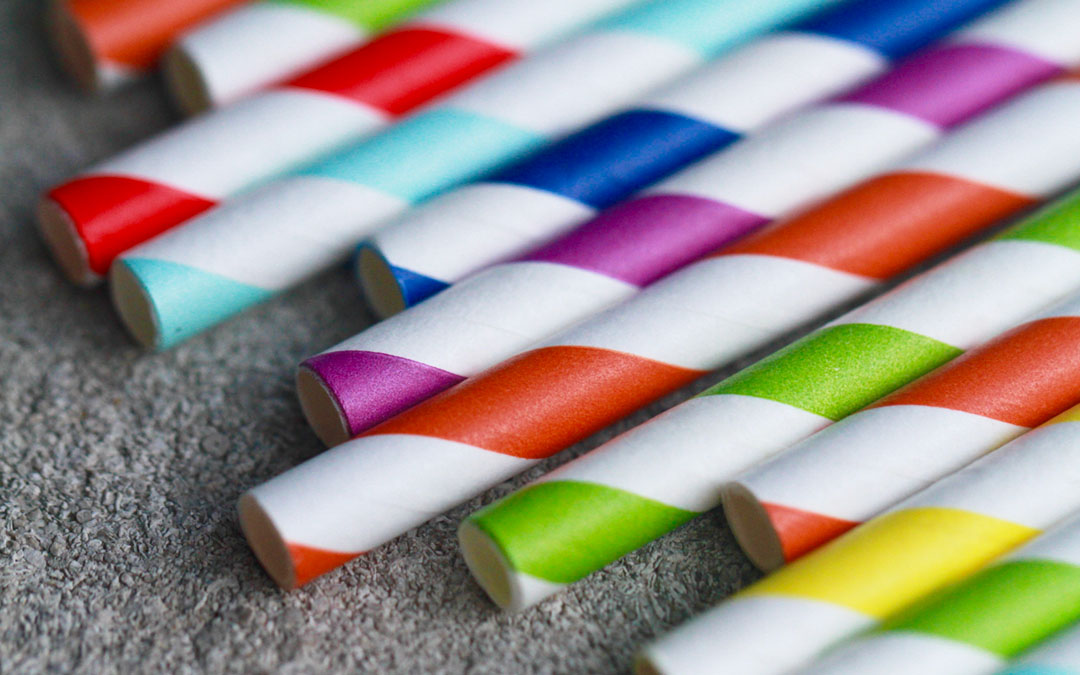Though they were first patented in 1888 by a man named Marvin Stone, drinking straws essentially date back to ancient times. 5,000 years ago, ancient Sumerians would plunge long, thin tubes (made from precious metals) into jars to reach the brewed liquid beneath fermented grain (yes, they were beer lovers!). Drinking straws are unquestionably a great invention.
They place less stress on teeth (less sugar contacting those pearly whites!), make things easier to drink, and are (arguably) a more hygienic way to consume liquids. And for the elderly and very young, they can be an essential tool for avoiding major spills or frustrations.
Plastic straws have been in the news a lot lately. Imagery of their impact on sea life has caused international outrage, and their contribution to littering has prompted demands for outright bans. This has led many people to seek out alternatives to plastic straws that let them keep sipping tasty beverages without harming the planet. Let’s check out the good, the bad, and the ugly, shall we?
Biodegradable Plastic Straws
Regular plastic straws are made from polypropylene or polystyrene. Derived from petroleum, these materials are chosen to keep costs low. Biodegradable plastic straws, however, are made from plant-based plastics. Right away, these guys seem better for the environment, right?
The problem is that they don’t biodegrade under normal conditions (like how food or cardboard does). Instead, these straws need special industrial compactors or heaters to degrade, adding carbon to our planet’s atmosphere.
So, while they’re certainly an alternative to plastic straws, and can still be made into any common straw form (transparent, bendy, colour-changing, etc.), their benefit is questionable.
Paper Straws
Most straws are individually-wrapped in protective paper, so it makes a kind of sense to use paper for the straws themselves. This alternative has been all the rage since the wastefulness of plastic straws has come to light—these guys can be thrown in the compost bin just like all other paper.
However, the sudden popularity of plastic straws has also been their downfall. Most collapse in liquid relatively quickly, often forcing people to use multiple paper straws to finish just one drink. This increased use leads to increased production, arguably offsetting the environmental benefits of using paper straws in the first place.
In response, thicker-walled rigid paper straws have recently come to market, but their inflexibility and increased cost have kept them from being any kind of success. Rigid straws have also reportedly lead to small paper cuts on fingers and lips.
Bamboo Straws
Bamboo is one of the fastest-growing plants on Earth and has become one of the most attractive alternatives to plastic straws. Bamboo straws are strong and reusable—just a quick wash with hot, soapy water (and some drying time) and they’re ready for use again.
One of the most durable materials in the world, it’s increasingly used in production of furniture, office supplies and even clothing. Bamboo straws have been known to last years, even with everyday use.
The problem with bamboo straws (and other reusable options) is that humans are forgetful creatures. Leaving the house in the morning is often a scramble. Trying to grab your keys, phone, wallet and other necessities is at the forefront of someone’s mind. A freshly washed straw laying in the drying rack is easy to forget.
Grass Straws
Sedge grass, native to East Asia, has a hollow stem and is one of the newest alternatives to plastic straws. Cheap to produce, quick to replenish, and free of chemicals, they also have the unique advantage of being both edible and good for your teeth. And like any natural resource, they’ll break down quickly and easily in the compost bin.
Sounds great, right? You must be asking, hey, what’s the catch?
Grass straws have a relatively short shelf life. Fresh straws last only two weeks and must be refrigerated. Dried straws can last up to 6 months, but they’re also more expensive.
Steel Straws
Another reusable option, steel straws have an incredibly long lifespan and can be handled like cutlery—plus, they have a shine that really catches the eye. They’re also one of the few recyclable straws on the market. Every time one is recycled, it contributes to the making of a brand new one. That’s huge.
Unfortunately, they have the same downfall of other reusable straws—they’re easily forgotten on the dish drying rack.
There’s also a chance of injury with the use of steel straws. A few news stories have detailed how the inflexibility and possible improper use of steel straws has led to injuries like finger cuts and mouth lacerations.
For restaurants, reusable steel straws offer a possible alternative to wasteful plastic ones. However, they’ll need to consider the liability surrounding their use.
Hay Straws
These guys are made from an incredibly abundant resource—wheat!
After harvesting, wheat stems generally aren’t used for food production and end up becoming compost. While this is absolutely a win, using them for straws is another way to ensure that every part of this natural resource gets used productively. They’ve emerged as a strong competitor in the disposable category, thanks to their low cost and ability to keep their shape (we’re looking at you, paper straws!).
However, hay straws aren’t a great option for those who suffer from hay fever or other related allergies. There’s also been reports of hay straws imparting a taste into liquids. That’s no fun, especially when drinking beverages with little flavour, like water.
Edible Straws
What’s better than a straw that you can eat?!
Edible straws leave zero mess (if you eat it after finishing your drink—c’mon, you know you at least want to try it!). Cereal companies have used them for years, giving kids a fun way to drink leftover milk. It’s about time they hit the mainstream, huh?
Unlike other straws which can change a liquid’s taste, edible straws are usually flavourless. In turn, this means they can also be used to add complementary flavours to a drink. Caramel in an iced coffee or a hint of lime in a cocktail—the possibilities are seemingly endless.
As a downside, edible straws can be seen as juvenile or unprofessional. Many people view them as strictly for use by kids and not for adults. They’re also expensive to produce, and companies will likely need many flavours to appeal to a wide variety of customers.
Of course, there’s another potential drawback to eating your straw. It can ruin your appetite. And who wants that right before a great meal?
And, don’t worry about not eating your straw. They’ll break down just like food in the compost.
Glass Straws
Glass containers are quickly becoming the norm, overtaking plastic and metal for cups and bottles. It only makes sense that glass straws would be a great complement to them. Glass straws can be made to match the specific design or colour of its matching container, and they provide an elegant yet fun feel to special occasions.
Glass straws look great, for sure. They’re also reusable, easy to clean and recyclable. But, they’re also a little bit dangerous if not handled correctly.
Glass straws don’t bend or flatten like their plastic counterparts. So, if you’re someone who tends to chew on their straws, you may be in for a mouth of shards. Higher-end (and more expensive) glass straws tend to be made thicker to withstand teeth—and show any damage before it hurts someone—but this is a genuine danger that mustn’t be overlooked.
These guys have major potential as an alternative to plastic straws, but we think we’ll wait until the “teething” issues are out of the way.
Silicone Straws
Silicone has a big advantage over the other reusable materials on this list—it’s flexible. It can bend and twist, biting down on it won’t hurt your teeth, and you won’t end up with a mouthful of glass. It’s a great choice for avoiding those potential injuries.
Silicone take less energy to produce than plastic, lasts longer (before drying out) and creates less waste (thanks to its recyclability). Silicone straws often come in a variety of cool colours, and they tend to be among the most popular and attractive straws on the market.
All these great points seem to make it the ideal material for a reusable straw. However, their environmental track record is just not as strong as the others. Silicone isn’t a natural material, often formed out of petroleum (just like plastic). It doesn’t biodegrade in in a landfill (just like plastic). And it could eventually find its way into the ocean and harm wildlife (just like plastic).
Pasta Straws
Ever looked at tube pasta and thought, “I could use this as a straw?”
Well, you’re not alone—there are already pasta straws on the market. Made from flour, these straws are rigid and can be composted just like regular pasta.
The biggest complaint about pasta straws (and other non-flexible straws) is that they just don’t feel like regular drinking straws. The thing about change is that it’s hard. It takes a while for people to adjust to unfamiliar things. And some people are just unwilling to try new things.
You must admit, pasta straws have the funniest name ever. They’re worth trying just for that.
Bonus: No Straw
The most environmentally-friendly straw is no straw at all. While it’s not a welcome option for everyone, opting for no straw means personally generating no waste. And, of course, there are certainly legitimate reasons to use one, as well (sanitation, disability, dental health, personal preference).
Thanks to a more eco-centric worldview, there are now plenty of options when it comes to drinking straws: reusable vs. disposable, recyclable vs biodegradable, natural vs. man-made. Choosing the perfect straw is a big decision, but we hope with this list of alternatives to plastic straws, we’ve helped you make an informed one.
Be sure to visit The Packaging Company for all your standard and custom packaging supply needs.




